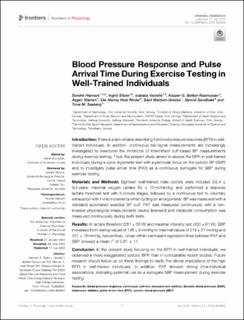| dc.contributor.author | Heimark, Sondre | |
| dc.contributor.author | Eitzen, Ingrid | |
| dc.contributor.author | Vianello, Isabella | |
| dc.contributor.author | Bøtker-Rasmussen, Kasper | |
| dc.contributor.author | Mamen, Asgeir | |
| dc.contributor.author | Rindal, Ole Marius Hoel | |
| dc.contributor.author | Waldum-Grevbo, Bård | |
| dc.contributor.author | Sandbakk, Øyvind | |
| dc.contributor.author | Seeberg, Trine Margrethe | |
| dc.date.accessioned | 2023-02-22T14:34:15Z | |
| dc.date.available | 2023-02-22T14:34:15Z | |
| dc.date.created | 2022-08-19T13:23:14Z | |
| dc.date.issued | 2022 | |
| dc.identifier.citation | Front. Physiol. 2022, 13:863855 | en_US |
| dc.identifier.issn | 1664-042X | |
| dc.identifier.uri | https://hdl.handle.net/11250/3053383 | |
| dc.description.abstract | Introduction: There is a lack of data describing the blood pressure response (BPR) in well-trained individuals. In addition, continuous bio-signal measurements are increasingly investigated to overcome the limitations of intermittent cuff-based BP measurements during exercise testing. Thus, the present study aimed to assess the BPR in well-trained individuals during a cycle ergometer test with a particular focus on the systolic BP (SBP) and to investigate pulse arrival time (PAT) as a continuous surrogate for SBP during exercise testing.
Materials and Methods: Eighteen well-trained male cyclists were included (32.4 ± 9.4 years; maximal oxygen uptake 63 ± 10 ml/min/kg) and performed a stepwise lactate threshold test with 5-minute stages, followed by a continuous test to voluntary exhaustion with 1-min increments when cycling on an ergometer. BP was measured with a standard automated exercise BP cuff. PAT was measured continuously with a noninvasive physiological measurements device (IsenseU) and metabolic consumption was measured continuously during both tests.
Results: At lactate threshold (281 ± 56 W) and maximal intensity test (403 ± 61 W), SBP increased from resting values of 136 ± 9 mmHg to maximal values of 219 ± 21 mmHg and 231 ± 18 mmHg, respectively. Linear within-participant regression lines between PAT and SBP showed a mean r 2 of 0.81 ± 17.
Conclusion: In the present study focusing on the BPR in well-trained individuals, we observed a more exaggerated systolic BPR than in comparable recent studies. Future research should follow up on these findings to clarify the clinical implications of the high BPR in well-trained individuals. In addition, PAT showed strong intra-individual associations, indicating potential use as a surrogate SBP measurement during exercise testing. | en_US |
| dc.language.iso | eng | en_US |
| dc.rights | Navngivelse 4.0 Internasjonal | * |
| dc.rights.uri | http://creativecommons.org/licenses/by/4.0/deed.no | * |
| dc.subject | blood pressure response | en_US |
| dc.subject | diastolic blood pressure | en_US |
| dc.subject | pulse arrival time | en_US |
| dc.subject | systolic blood pressure | en_US |
| dc.subject | continuous cuff-less measurement method | en_US |
| dc.subject | endurance athletes | en_US |
| dc.subject | utholdenhetsutøvere | en_US |
| dc.subject | pulstrykk | en_US |
| dc.subject | diastolisk trykk | en_US |
| dc.subject | systolisk trykk | en_US |
| dc.subject | blodtrykk | en_US |
| dc.title | Blood Pressure Response and Pulse Arrival Time During Exercise Testing in Well-Trained Individuals | en_US |
| dc.type | Peer reviewed | en_US |
| dc.type | Journal article | en_US |
| dc.description.version | publishedVersion | en_US |
| dc.source.volume | 13 | en_US |
| dc.source.journal | Frontiers in Physiology | en_US |
| dc.identifier.doi | 10.3389/fphys.2022.863855 | |
| dc.identifier.cristin | 2044513 | |
| dc.relation.project | Norges forskningsråd: 282039 | en_US |
| dc.source.articlenumber | 863855 | en_US |
| cristin.ispublished | true | |
| cristin.fulltext | original | |
| cristin.qualitycode | 1 | |

